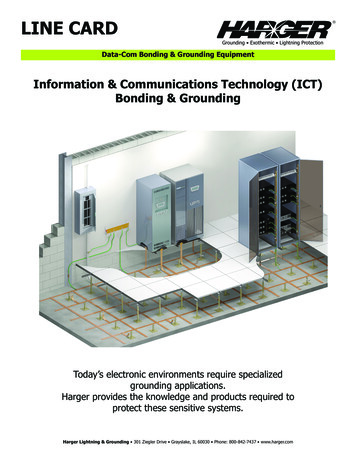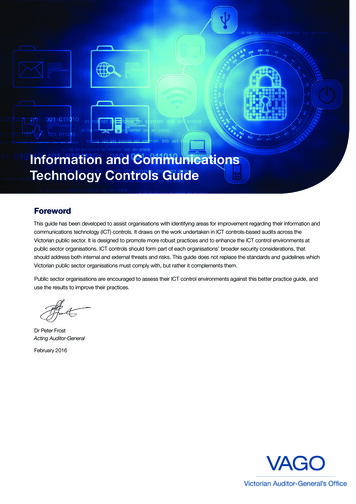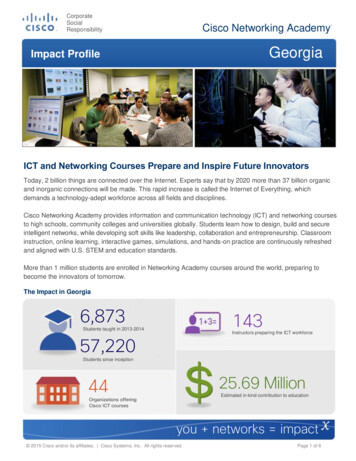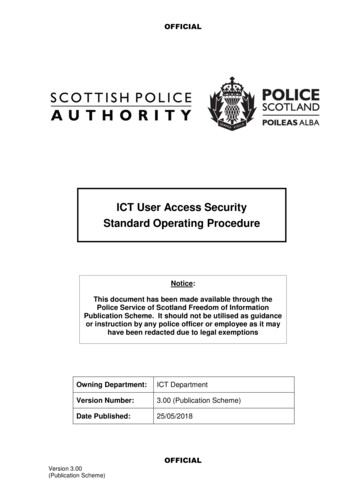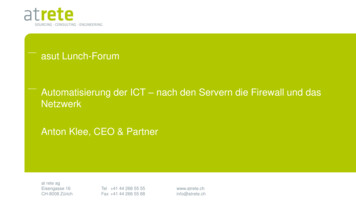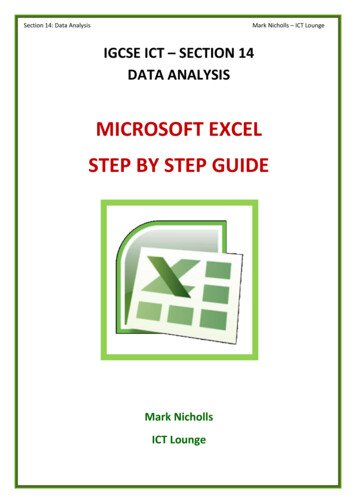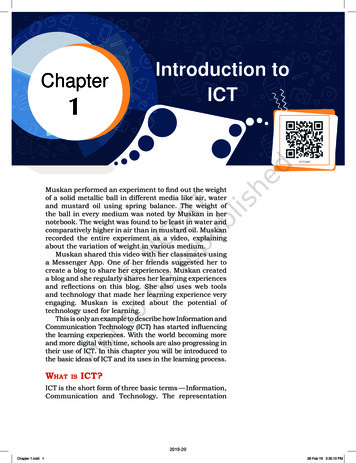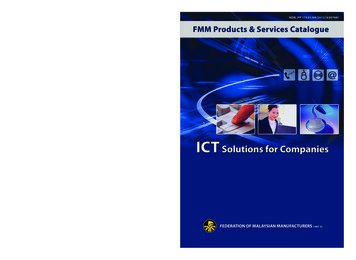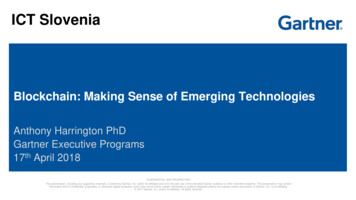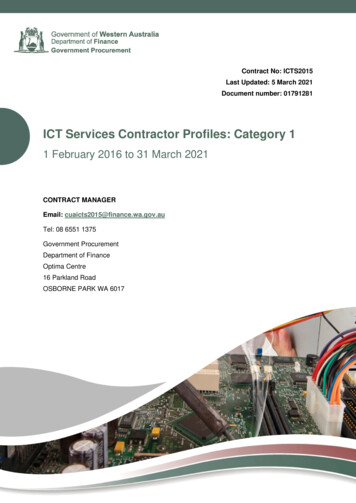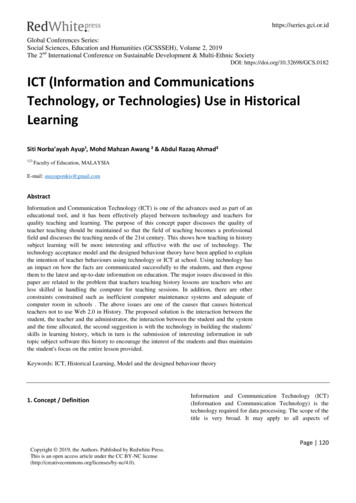
Transcription
https://series.gci.or.idGlobal Conferences Series:Social Sciences, Education and Humanities (GCSSSEH), Volume 2, 2019The 2nd International Conference on Sustainable Development & Multi-Ethnic SocietyDOI: https://doi.org/10.32698/GCS.0182ICT (Information and CommunicationsTechnology, or Technologies) Use in HistoricalLearningSiti Norba’ayah Ayup¹, Mohd Mahzan Awang ² & Abdul Razaq Ahmad³123Faculty of Education, MALAYSIAE-mail: snayupsmkis@gmail.comAbstractInformation and Communication Technology (ICT) is one of the advances used as part of aneducational tool, and it has been effectively played between technology and teachers forquality teaching and learning. The purpose of this concept paper discusses the quality ofteacher teaching should be maintained so that the field of teaching becomes a professionalfield and discusses the teaching needs of the 21st century. This shows how teaching in historysubject learning will be more interesting and effective with the use of technology. Thetechnology acceptance model and the designed behaviour theory have been applied to explainthe intention of teacher behaviours using technology or ICT at school. Using technology hasan impact on how the facts are communicated successfully to the students, and then exposethem to the latest and up-to-date information on education. The major issues discussed in thispaper are related to the problem that teachers teaching history lessons are teachers who areless skilled in handling the computer for teaching sessions. In addition, there are otherconstraints constrained such as inefficient computer maintenance systems and adequate ofcomputer room in schools . The above issues are one of the causes that causes historicalteachers not to use Web 2.0 in History. The proposed solution is the interaction between thestudent, the teacher and the administrator, the interaction between the student and the systemand the time allocated, the second suggestion is with the technology in building the students'skills in learning history, which in turn is the submission of interesting information in subtopic subject software this history to encourage the interest of the students and thus maintainsthe student's focus on the entire lesson provided.Keywords: ICT, Historical Learning, Model and the designed behaviour theory1. Concept / DefinitionInformation and Communication Technology (ICT)(Information and Communication Technology) is thetechnology required for data processing. The scope of thetitle is very broad. It may apply to all aspects ofPage 120Copyright 2019, the Authors. Published by Redwhite Press.This is an open access article under the CC BY-NC 4.0).
Global Conferences Series: Social Sciences, Education and Humanities (GCSSSEH), Volume 2, 2019information management and processing. The accuracyand ease of use is the use of computers and software tomodify, store, protect, process, transfer, view, and obtaininformation regardless of place and time. InformationTechnology (IT) and Information and CommunicationTechnology (ICT) are the technology needed for dataprocessing.As is commonly known, technology is characterized as aform of facilitator that enables the flow of information tobe very fast. Actually information technology is notlimited to internet and computers only but it involvestelevision, telephones, mobile phones, faxes, telegrams,PDAs and satellite systems in communicatinginformation to recipients. The term "informationtechnology" emerged in the 1970s. In the 20th century,many industries grew rapidly in the wake of theelectronics sector, the computing sector, and othertechnological fields.There are three important principles in the useof information technology. The first informationtechnology is to collect information. It is used for editingby technology. For example, by using a computer it canrecord sounds, images and as a motion sensor. Secondly,it is to manipulate the image information and process.Thirdly, it is used to communicate that it explains howinformation technology is used to communicate to obtaininformation from sources to recipients.2. Theory / ModelThe theory used is based on the Technology AcceptanceModel by Davis et al. (1989). Based on the built-inframework has good skill level in Internet usage andminimum constraints in Internet usage which will lead tothe achievement of Internet use as R & D medium inschools. Model of Technology Acceptance (Davis 1989;Davis et al., 1989) deals with the Theory of ReasonedAction (Ajzen & Fishbein 1980; Fishbein & Ajzen1975).Action Theory Cause expressing trust affectsattitudes. This attitude leads to the intention of beingtranslated into behaviour. The Technology AcceptanceModel is used to describe the acceptance of userstowards the use of technology, especially informationsystems. This model states that the actual use of a systemsuch as a computer-based system is determined by theuser's attitude towards such a system.Past studies Wong (2002) and Speier et al.(1995), the actual use of a system can be measured basedon the user's knowledge and skills on the system. Toensure users are using technology, users first trust orassume a system as useful. Conversely, if the user doesnot trust the usefulness of the system, the targetedindividual will not use that technology. It can thereforebe seen that ease of use is not important with the notionof use because the difficulty of using the system can beovercome if the user considers the system useful to him(Davis et al., 1989). Consequently, conceptualframeworks are based on skills, attitudes towards Internetuse, and the lack of skills in Internet use are expected toinfluence the level of Internet usage.3. IssueThe main issue of using ICT in history learning is thatteachers who teach historical teaching are less skilledteachers in handling computers for teaching sessions. Inaddition, there are other constraints such as inefficientcomputer maintenance systems in schools and adequatecomputer room problems. The above issues are one ofthe causes that causes historical teachers not to use Web2.0 in History learning. Next is a Web History scarcityproblem that causes fewer students leveraging theInternet as an alternative that provides access to a varietyof helpful information in R & D. Time management isalso one of the factors that causes students not to usecomputers and the Internet. Use of the Internet requiresthe right time for students to avoid interrupting their R &D processes. This is because Internet usage might take awhile to be accessed and accessed.The second issue is that at the time ofglobalization today, today's Education is global and isoften linked to the achievement of learning outcomes andgraduates' marketability. The advancement ofcommunication and information technology (ICT) hasmade the world community and an organization moreconnected together in a borderless world community.Education should provide knowledge and skills to createthe future generations of the world's society. Educationthrough learning is one of the alternatives that cannot beresisted by all levels of students that are compatible withtoday's lifestyle that is paperless, Wi-Fi and overdependent on smartphones. Educational institutionsshould be prepared to change mainly from the aspect ofteaching approaches to continue to be accepted by thecommunity and to attract students. Smartphone apps,WhatsApp and Telegram offer an alternative toimproving the quality of education as well as theeffectiveness of financial management as a result ofcontrols over the needs of human resources and facilities.4. ImplicationsPage 121
Global Conferences Series: Social Sciences, Education and Humanities (GCSSSEH), Volume 2, 2019The implications of technology in the learning of historyare demanded because of the 21st century learning thatall multidisciplinary students, acting like computers, arecapable of managing knowledge, literacy to new media,smart and proficient thinking and possessing soft skills,namely social intelligence, sensitive, cross-brandingculture, open mind and ability to engage in virtualcollaboration. Furthermore, this skill is needed to keepabreast of changes in the industry and the worldcommunity as a result of industry dependence andservice system on smart machines and robots, deliverysystems and records that make every activity as a datasource and programmed, a way of communicating a newway that in turn makes every organization a megastructured and the world is increasingly linked to eachother.Learning using WhatsApp and Telegramapplications is part of the path to meeting the expertise ofthe workforce required by the industry and the futurelifestyle. In addition, social media also provides a goodlanguage learning context. Facebook discussions, forexample, help students connect with students fromabroad who need them to use English correctly. Overall,the effectiveness of Web 2.0 application use in teachingand learning among teachers is at a high level with theoverall mean score of 3.96 and the standard deviation is0.611. Based on Table 7, the highest mean is thatteachers can send anything in the form of notes, quizzesand exercises easily, interestingly, effectively and with abeautiful and attractive look.The lowest point is the use of applications suchas Facebook, Twitter, Google docs, Skype, slide sharingand others to collaborate on Research and Development.The new approach to Mobile Learning can be applied notonly to the learning situation for those who are or whohave worked, but also to the situation in primary andsecondary levels. In general, the use of tools in MobileLearning that is more widely available to all groups willhelp to eliminate illiteracy among the community of tireand rural areas. Its mobile nature or unlimited form oflearning at the place and time gives everyone theopportunity to continue their studies and learning.Implementation of Mobile Learning will help reduceilliteracy rates for less developed countries. For countrieswith high populations and also poor countries, educationdevelopment requires significant expenditure, especiallyfor the development of infrastructure, educationalequipment and payroll of workers. As mobile devices areproven to be cheaper to be used in education, this type oflearning approach is more appropriate to help increaseliteracy of accessory technology in developing countries.5. ChallengeAmong the key challenges are the lack of support toolsand wireless telecommunications infrastructures in ruralareas and the design of learning content that takes intoaccount the cultural aspects. This is because governmentsupport, student motivation and the involvement of apotential culture for learning content are among theopportunities that drive the latest technologicaldevelopments.According to previous studies Hazwani andDalbir (2016) have stated the question that mobiletechnology among students is influenced by two sets ofconflicting features ie characteristics as the generation Yand cultural values inherited. For example, as GenerationY they want to be quick and vocal, but they alsohighlight the inherent cultural traits that are toodependent on teachers, giving feedback only when askedby teachers and communicating within the groupmembers. In addition to the above challenges there isalso a challenge in creating a virtual learningenvironment or online learning or learning VirtualLearning, there are some challenges that are seen asobstacles to ensuring the success of virtual teaching.Among the major obstacles identified is theInternet access facility. Norzilawati et al. (2013) statesthat the speed Internet access issues are an obstacleespecially to rural and remote schools with very limitedInternet access and prevent teachers from using thesefacilities optimally. It becomes a dilemma to teachers toimplement this facility. Challenges explore the readinessand ability of students to follow learning throughWhatsApp and Telegram platforms and explore whetherthey help students master the learning outcomes.Students generally are not exposed to mlearning but are ready to learn them and have a positiveperspective that the learning can enhance the image ofthe institution and the skills of graduates. Learning canoccur on WhatsApp and Telegram platforms and it helpsstudents master learning outcomes. A more detailedstudy is needed to know the aspects of self-study andhow students and lecturers need to adapt to the variousfeedback provided by students on WhatsApp andTelegram platforms.6. Suggestions For Problem SolvingSuggestions for problem solving of technology use inhistorical learning that need to be addressed, namely theinteraction between students, teachers and administrators,interactions between students and systems and the timePage 122
Global Conferences Series: Social Sciences, Education and Humanities (GCSSSEH), Volume 2, 2019allocated for each interaction (Fahad 2010). A culturalaspect that surrounds student thinking needs to beaddressed so they are more open and interact positivelyand build on the WhatsApp and Telegram platforms(Shamsul Arrieya 2011), especially in the early stages ofits introduction (Robin 2011).Further studies have to be done to determine thelevel of self-learning among students and how historyteachers can guide students towards exploringknowledge, meaningful sharing of information anddeveloping the ability to argue on WhatsApp andTelegram platforms. This aspect is important if the lessonis to be introduced to a large-sized group of students sothat nothing is just to ride on the platform. The secondsuggestion of the solution is that the use of multimediasoftware not only affects the development of studentknowledge of a chapter in the lesson but can developtheir skills in computer literacy. According to the studyof Ros Emiliana (2007) and Lachs (2006), the use oftechnology in historical learning can also enhance thestudents' skills in the use of computer literacy. This, byusing a computer in learning, can add students' skills inmanaging computer systems in their daily lives.The next suggestion is that using the MobileLearning implementation in the future curriculum is achange to the teacher's own function. Teachers are nolonger teaching all week in the classroom but beingmonitored and facilitated at their own teaching centre.Teachers and lecturers need to have the skills in using allthe tools and programs used in Mobile Learning thatenable them at the same time to become proficient inplanning instruction on learning activities, Hence, relatedparties must plan ahead before The emergence of suchtechnology in the country includes in terms of trainingand related courses.7. SummaryOverall, this concept paper has identified the level ofknowledge, skill level, attitudes, level of skill constraints,Web 2.0 level of use and the level of effectiveness ofWeb 2.0 and Internet usage in History. However, keep inmind that technology is only a tool in the Research anddevelopment process, it will not be able to replace theteacher's position in a broad sense. Today's education isfor future excellence. Students should be prepared tocarry out new tasks to develop TMK in learning process.Students should have shifted from conventionallearning methods to dynamic learning in the context ofICT usage. In addition, students should also be preparedto increase their knowledge and skills to make computersas learning technology in place of conventionalapproaches that are less technology-based (Zamri &Mohamed Amin 2008). This study is supported by IdaNorini (2013) study on the effectiveness of the conceptof VLE Frog's virtual teaching environment amongstudents. He found that all the students, 100%, liked thecomputer laboratory because they had a new learningatmosphere and from teacher observations they alsofound students excited when they could enter thecomputer lab and use this app.The phenomenon of the TMK wave, haschallenged the education system including learningtheory to change. The impact is now cyberspace andvirtual universities providing learning remotely or onlinevia the World Wide Web (WWW) with the help of TMKtools. Significantly, the speed of application science andthe evolution of communication technology has changedthe pattern of the community in today's society.Computer-based communications are not limited todisseminating information, but the potential of thetechnology has become more sophisticated by providing,collecting and processing informational knowledge.Thus, TMK through Internet technology is an importantmedium in preparing a globally-capable community inthe 21st century.This is a good start for this student to traversethe increasingly challenging TMK in education. The useof computers as the main medium in the TMK learningprocess is well received by students. Some changes in thelearning process approach apply. Among them is achange of focus from teacher-centred teaching to studentcentred learning (Zamri 2014, Saemah & Zamri 2017). Inthis case the student becomes a focus on learningactivities oriented to the exploration and discoveryprocess based on the Constructivist Theory approach.TMK's development has created a new flexible learningenvironment in terms of time, place, method and learningmaterials, as well as creating more opportunities forgreater collaboration processes in the education process.Researchers consider students to take full advantage ofthe use of virtual learning supplied at school and toattract students to the use of TMK in line with thegovernment's call in order to make education in ourcountry a world-classReferences[1] Ida Norini Mahamad Tajudin. 2013. Kajian itaran pengajaran maya frog (VLE Frog) dikalangan pelajar SK Haji Mahmud Chemor, Perak.Page 123
Global Conferences Series: Social Sciences, Education and Humanities (GCSSSEH), Volume 2, 2019Kertas Projek Penyelidikan. Fakulti Bahasa danKomunikasi, Universiti Perguruan Sultan Idris.[2] Rahimah Sabtu. 2013. Penggunaan web 2.0 dalampengajaran KOMSAS Bahasa Melayu murid sekolahmenengah. Kertas Projek Sarjana Pendidikan.Fakulti Pendidikan, Universiti Kebangsaan Malaysia.Saemah Rahman & Zamri Mahamod. 2017. Inovasipengajaran dan pembelajaran: Mengoptimumkanpembelajaran pelajar. Kuala Lumpur: Dewan Bahasadan Pustaka. Sharifah Nor Puteh & Kamarul Azman.2011. Tahap kesediaan penggunaan ICT dalampengajaran dan kesannya terhadap hasil kerja dantingkah laku pelajar prasekolah. Jurnal PendidikanMalaysia, 36(1): 25-34.[3] Shamsudin Mohamad, Kamarul Azmi Jasmi . UTM Press, UTM, Skudai.[4] Shamsul Arrieya Ariffin. 2011. Mobile learning inthe institution of higher learning for Malaysiastudents: Culture perspectives. Proceeding of theInternational Conference on Advanced Science,Engineering and Information Technology. 14 – 15Januari 2011, Hotel Equatorial Bangi-Putrajaya,Malaysia.[5] Norazilawati Abdullah, Noraini Mohd Noh, & NikAzmah Nik Yusuf. 2013. Aplikasi persekitaranpengajaran maya (Frog VLE) dalam kalangan gurusains. Prosiding 7th International MalaysianEducation Technology Convention (IMETC). HotelGolden Flower Bandong. 16-18 September[6] Norbayah Mohd Suki & Norazah Mohd Suki. 2010.The usage of mobile device for learning: A casestudy. IJUTFD, 1 (1): 111. Oluwafisayo[7] Yahya Othman & Roselan Baki. 2008. Aplikasikomputer dalam pengajaran bahasa: penguasaanguru dan kekangan dalam pelaksanaan. 1stInternational Malaysian Educational TechnologyConvention.[8] Zamri Mahamod &Mohamed Amin Embi. (2008).Teknologi Malumat dan Komunikasi dalampengajaran dan pembelajaran Bahasa Melayu: teoridan praktis. Shah Alam: Karisma Publications Sdn.Bhd.[9] Zamri Mahamod & Nur Aisyah Mohamad Noor.(2011). Persepsi guru tentang penggunaan aplikasimultimedia dalam pengajaran komponen sasterabahasa Melayu. GEMA OnlineTM Journal ofLanguage Studies, 11(3), hlm163-177.Page 124
framework has good skill level in Internet usage and minimum constraints in Internet usage which will lead to the achievement of Internet use as R & D medium in schools. Model of Technology Acceptance (Davis 1989; Davis et al., 1989) deals with the Theory of Reasoned Actio
